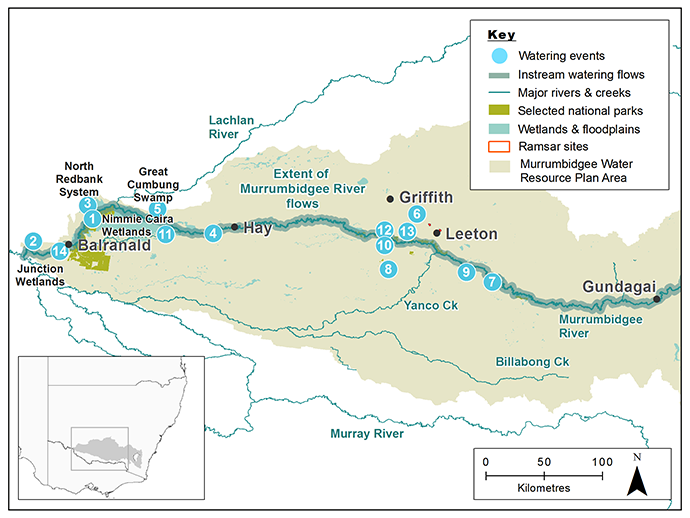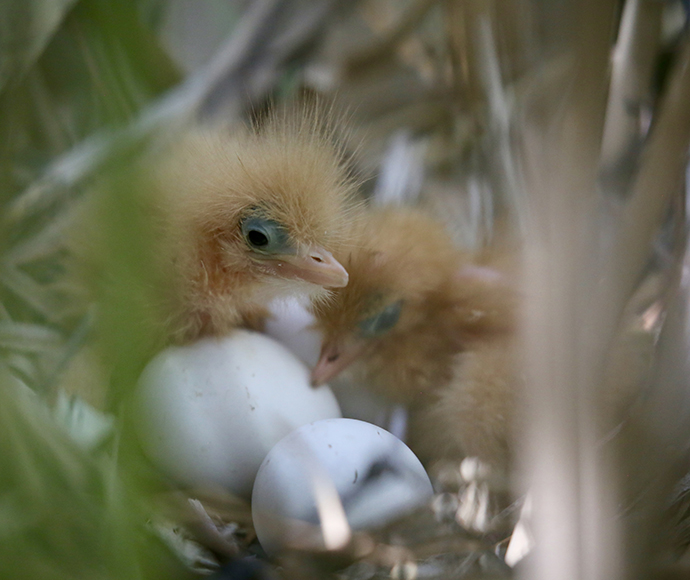The Murrumbidgee catchment saw very dry conditions and significantly lower than average inflows in 2018–19. This resulted in only a 7% general security allocation (the average carry over was 22%) with about 110 gigalitres of New South Wales environmental water allowances available for use.
To build on low starting allocations, water was carried over from the 2017–18 water year. Under these conditions, the Department of Planning, Industry and Environment – Environment, Energy and Science’s (DPIE–EES) Water for the Environment Team worked with the Commonwealth Environmental Water Holder to water Yanga National Park. This priority event inundated thousands of hectares of wetlands, lakes and red gum forest in the park.
Remaining water for the environment was used to maintain refuge habitats for native fish, frogs and turtles as well as habitat important to waterbird species such as Australasian bitterns. Significant outcomes included:
- improved condition of wetland vegetation communities in the Lower Murrumbidgee
- improved fish habitat during low flows and heat-wave conditions
- golden perch recruitment
- Australasian bittern breeding (Yanga)
- colonial waterbird breeding (Yanga egret rookery).

Map of the Murrumbidgee catchment showing waterways, wetlands and locations of water for the environment deliveries made in 2018–19.
Watering aims
After a successful wetland reconnection flow in 2017–18, plans were put in place to use water for the environment primarily in the Lowbidgee Floodplain.
The Murrumbidgee Environmental Water Advisory Group considered the condition of river and wetland assets, water availability and weather forecasts and recommended flows to support a range of ecological outcomes. The main aims of the flows were to:
- use existing infrastructure to connect the wetlands of the Lowbidgee Floodplain with the river, providing opportunities for native fish to feed, breed and move
- provide habitat for the threatened Southern bell frog
- encourage the ongoing recovery of native wetland plants to provide habitat, feeding and breeding opportunities for a range of native animals
- provide foraging and breeding opportunities for waterbirds including bitterns
- replenish wetland refuges in anticipation of possible dry times in the future.
Water delivery
This table provides a summary of water for the environment delivered in the Murrumbidgee catchment during the 2018–19 watering year. Volumes are indicative only.
Notes: Location numbers in the table relate to watering events marked on the map.
NSW = NSW licensed environmental water; CEW = Commonwealth licensed environmental water; EWA = Environmental water allowance accrued under the Water Sharing Plan for the Murrumbidgee Regulated River Water Source 2016; TLM = The Living Murray.
| Watering event number | Location | Start date | Finish date | NSW | CEW | EWA | TLM | Total |
|---|---|---|---|---|---|---|---|---|
| 1 | Yanga National Park: recovery of native fish | 20 Aug 2018 | 31 Jan 2019 | – | 40,500 | 69,294 | – | 109,794 |
| 2 | Waldaira and Mainie Wetlands | 11 Sep 2018 | 15 Mar 2019 | – | 3700 | – | – | 3700 |
| 3 | North Redbank Wetlands: connectivity flow | 18 Sep 2018 | 19 Nov 2017 | – | 6000 | 21,000 | – | 27,000 |
| 4 | Toogimbie Wetlands: waterbird breeding | 20 Sep 2018 | 22 Mar 2019 | – | 900 | – | – | 900 |
| 5 | Nap Nap to Waugorah Lagoon: support waterbird breeding | 25 Sep 2018 | 2 Nov 2018 | – | – | 11,419 | – | 11,419 |
| 6 | Murrumbidgee Irrigation Area Wetlands | 28 Sep 2018 | 9 May 2019 | – | 2998 | – | – | 2998 |
| 7 | Sandy Creek Wetlands: waterbird breeding | 29 Sep 2018 | 1 Nov 2018 | – | 400 | – | – | 400 |
| 8 | Coleambally Irrigation Area Wetlands: waterbird breeding | 6 Oct 2018 | 18 Nov 2018 | – | – | 4216 | – | 4216 |
| 9 | Oak Creek and Gras Innes: support threatened native fish | 8 Nov 2018 | 15 Nov 2018 | – | – | 600 | – | 600 |
| 10 | Yarradda Lagoon pumping: support waterbird breeding | 16 Nov 2018 | 18 Jan 2019 | – | 2014 | – | – | 2014 |
| 11 | Nimmie–Caira Wetlands: waterbird breeding | 1 Dec 2018 | 23 May 2019 | – | 1505 | 2795 | – | 4300 |
| 12 | Darlington Lagoon: support threatened native fish/td> | 20 Dec 2018 | 31 May 2019 | – | 397 | – | – | 397 |
| 13 | Gooragool and Matangry Lagoons: connectivity flow | 23 Jan 2019 | 24 Jan 2019 | – | 83 | – | – | 83 |
| 14 | Lower Murrumbidgee: native fish flow | 30 Jan 2019 | 9 Apr 2019 | – | 3300 | 8200 | 16,100 | 27,600 |
| Region | Total |
|---|---|
| NSW | - |
| CEW | 61,797 |
| EWA | 117,524 |
| TLM | 16,100 |
| Total | 195,421 |
Outcomes
In partnership with the Murrumbidgee Environmental Water Advisory Group and Commonwealth Environmental Water Holder, the DPIE–EES Water for the Environment Team delivered much of the available water for the environment to the Lowbidgee Floodplain, primarily to wetland systems in Yanga National Park and North Redbank.
This water:
- triggered a golden perch spawning and recruitment event in Tala Creek
- initiated and maintained an egret rookery at Tarwillie Swamp (Yanga National Park), with about 300 egret nests detected, among other species
- created conditions suitable for successful breeding of 2 threatened species, the Australasian bittern and Southern bell frog
- improved conditions for native fish in the lower reaches of the Murrumbidgee River during a record heat wave
- helped mitigate hypoxic (low oxygen levels) water quality conditions that had resulted in fish deaths in Redbank Weir
- most likely averted a future fish kill at Maude Weir, as indicated by monitoring.
Darlington Lagoon, which was hard-hit by the Millennium Drought, began its road to recovery with managed flows improving the condition of wetland vegetation including river red gums, water primrose and red water milfoil. Pumped delivery of water for the environment via neighbouring irrigation infrastructure boosted habitat health at the site.
Case study: Yanga National Park watering
We collaborated with the Commonwealth Environmental Water Holder to deliver water into Yanga National Park in 2018–19.
A total of 110 gigalitres of water flowed into Yanga’s wetlands, lakes and river red gum forests via Redbank and Maude weirs.
This water benefited a range of species and the flow:
- triggered and sustained the largest colonial waterbird breeding event and the only documented egret rookery in the New South Wales portion of the Murray–Darling Basin in 2018–19
- supported breeding of 9 waterbird species, with 230 great egret nests found at one rookery at Tarwillie Swamp; smaller rookeries were recorded at other sites within the watering zone
- increased distribution of the threatened Southern bell frog, a useful indicator of habitat health, within the park; ground surveys and call recorders detected this species at sites including northern and central swamps in Yanga and creeks which supply water for the environment to the park from the east
- triggered a spawning response in the resident golden perch of permanent deep creeks and open lake habitats, which was detected by a monitoring program led by Charles Sturt University and jointly funded by DPIE–EES and the Commonwealth Environmental Water Office
- provided suitable habitat for the first recorded nesting of Australasian bitterns in the tall spike-rush swamps of Yanga National Park; surveys in late December 2018 and mid- to late-January 2019 reported this threatened waterbird at 3 sites, with breeding confirmed at one location, and suggested the birds favour areas of tall spike rush in open water.

Little bittern (Ixobrychus minutus) chicks and eggs in Yanga National Park